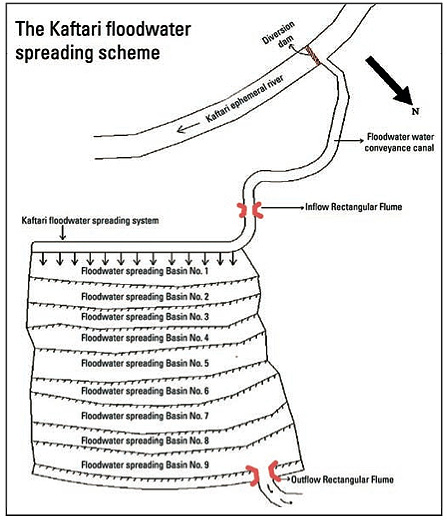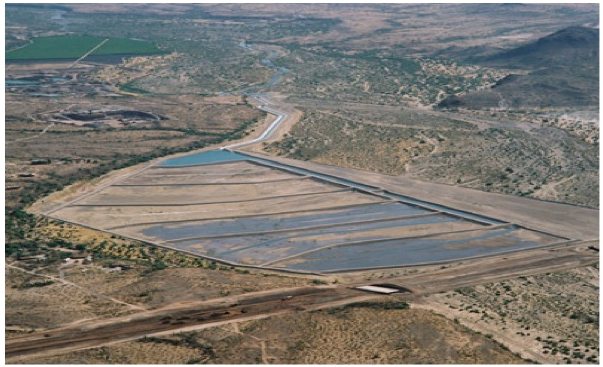Difference between revisions of "洪水控制/疏导水池"
Weichen Chen (talk | contribs) (→适宜条件) |
Weichen Chen (talk | contribs) (→Resilience to changes in the environment) |
||
| Line 23: | Line 23: | ||
|} | |} | ||
| − | === | + | ===应对环境变化的适应性=== |
| − | ==== | + | ====干旱==== |
| − | ''' | + | '''干旱的后果''': 农作物产量降低<br> |
| − | ''' | + | '''潜在的原因''': 灌溉农作物的洪水量减少<br> |
| − | ''' | + | '''增加 WASH 系统的适应性''': 防旱且生长周期短的作物;使农民种植的作物具有多样性 |
| − | + | 关于治理干旱的更多信息,请查看: [[易干旱地区具有适应性的WASH系统]]。 | |
====Floods==== | ====Floods==== | ||
Revision as of 02:00, 28 August 2015
这是一项利用洪水的技术,通过修建引水建筑物和运河将河水疏导至一大片区域,从而补给地下水和池塘、灌溉土地和牧场。这个技术的原理是当少量的水以最慢的速度流过土地时不会破坏土壤表面。这包括漫灌,也包括通过运河将河水疏导至田地的标准灌溉渠方法。
适宜条件
水流量大、水流湍急,并且不适合传统灌溉方式的地方(漫灌系统应该在已经应用的地方大力推广)。
| 优势 | 劣势 |
|---|---|
| - 不需要对土地进行太多准备,因此比其它渗入方式性价比更高 - 大部分河流中的沉淀物(如70%)会沉淀在土地上,有益于农业 |
- 需要大面积的土地 - 季节性河流的水量在时间和流量上难以预计,这将导致无法预计水流在土地上的流经面积,并会对这种方式造成损害 |
应对环境变化的适应性
干旱
干旱的后果: 农作物产量降低
潜在的原因: 灌溉农作物的洪水量减少
增加 WASH 系统的适应性: 防旱且生长周期短的作物;使农民种植的作物具有多样性
关于治理干旱的更多信息,请查看: 易干旱地区具有适应性的WASH系统。
Floods
Spreading basins are perfect for areas with floods. They are built to transfer excess water away from rivers, so that uncontrollable floods don't happen in unwanted places. However, in the event of too much flooding, the spreading basin must be large enough to handle the increased volumes of rain. Plus, with intense rain events, the higher velocities might be too much for the soil of the basin and create a washed out effect or likely just runoff before infiltrating. In this case, additional vegetation enhancement (to help the soils absorb more water), wetland enhancement, levee protection, and/or additional water storage will be helpful.
Construction, operations and maintenance
General advice on cement: A common cause of cracks in structures and linings (e.g. in tanks, dams, waterways, wells) is errors in mixing and applying the cement. First of all, it is important that only pure ingredients are used: clean water, clean sand, clean rocks. The materials have to be mixed very thoroughly. Secondly, the amount of water during mixing needs to minimal: the concrete or cement needs to be just workable, on the dry side even, and not fluid. Thirdly, it is essential that during curing the cement or concrete is kept moist at all times, for at least a week. Structures should be covered with plastic, large leaves or other materials during the curing period, and kept wet regularly.
Specific advice:
- It is better to concentrate efforts on low-cost diversion structures and to avoid sophisticated technological solutions. Efforts should be based on improving existing intakes.
- If using controlled flooding for irrigation, farmers should be more involved in development of improved spate systems – the new system should build on existing practices and land rights, not undermine them as has happened in the past.
Pre-construction considerations
Spate floods are variable and difficult to predict using conventional rainfall-runoff models because rainfall is often not correlated to runoff in ephemeral rivers that feed spate systems. Large scale permanent structures built to resist the hostile conditions of full river flow are economically unfeasible and also still prone to damage and siltation. Although siltation brings nutrients, it also creates one of the major difficulties with spate irrigation – sediment load tends to be between 3-10% in seasonal rivers with particle size varying from silt to boulders. Silt causes problems of silting up channels, raising farmland and causing river courses to change direction and miss the diversion structure altogether. There are also large quantities of floating debris which can cause problems for intakes.
The following are recommended:
- Rebuilding parts of the system after major floods can be a more cost-effective option than designing more permanent structures. Traditional diversion structures work well at a fraction of cost of other types and also work better – they can breach in high floods (heavy silt-laden water does not come out onto land).
- Improvements in water distribution and moisture conservation may be more beneficial than focusing only on improving diversion structure efficiency (see Bunds). Where this is not yet practised, it should be promoted.
- Physical changes to traditional systems should be made so as to be as flexible as possible, given the uncertain and highly variable nature of spate flows. Traditionally, spate irrigation has incorporated this flexibility with farmers moving to different areas when needed.
- Incremental structural reinforcements to existing traditional intakes have been proven as cost-effective and more successful than larger scale interventions.
- Simple diversion structures with no gate is made from gabions, rubble masonry or concrete. They are simpler for farmers to maintain using indigenous skills. Flow-restricting structures and rejection spillways need to be included at heads of canals to prevent large uncontrolled flows from damaging canals and irrigation infrastructure.
Operations and maintenance
Systems should be self-reliant with regards to routine operation and repair, but some backstopping from public sector units is a good idea:
- Spate systems rely on communal management and dialogue due to their scale. Projects should not attempt to unnecessarily formalize agreements for maintenance – farmers should be the drivers for this. However, any user associations should be based on catchments or communally-used areas.
- Provision of bulldozers has been very popular and has enabled spate farmers to build or restore damaged structures more easily. Problems with that is that sometimes downstream effects become too great since farmers upstream can build much larger structures, and also that bulldozers cannot easily be run and maintained in a self-sustaining fashion due to high costs. Support is therefore too large for small farmer groups and is best organized on a regional basis through local government, or with subsidies to allow participation of the private sector.
Field experiences

Drawing: Strategies for Managed Aquifer Recharge (MAR) in semi-arid areas. UNESCO.
Iran
Overexploitation of groundwater has caused significant drawdown of the water table (1.5m/year) and deterioration of groundwater quality in the Dorz Sayban Plain, which is located 115 km to the southeast of Larestan, Iran. 3500 hectares of land are irrigated using groundwater in this plain. To decrease the rate of the drawdown of the water table, five floodwater spreading systems for recharge of groundwater were designed and constructed in the region 1983 and 2001.
Inflow and outflow rates from the Kaftari floodwater spreading system were measured for nine flooding events during 2002-2003 using rectangular flumes in the system. The maximum inflow and outflow rates in the system were 20.3 and 7.26 m3/s, respectively. The total volume of inflow and outflow of the system was about 886,000 and 146,000 m3 for the nine flooding events. Therefore, 83.5% of the inflow to the system was recharged to the aquifer, only small quantities being lost to evaporation. This shows the high performance of floodwater spreading systems in the recharge of groundwater.
More than 70% of the suspended load has settled in the system. This will inevitably lead to clogging and reduction in efficiency in the system, but also an improvement of the soil for agriculture purposes. Additionally, the managed aquifer recharge improves the quality of groundwater, as the EC of floodwater is much lower than that of the groundwater (0.3-0.4 versus 2.0-9.0 dS/m).
Manuals, operations and maintenance
- Sustainable Development of Groundwater Resources in Southern and Eastern Africa. International Atomic Energy Agency.
Acknowledgements
- CARE Nederland, Desk Study: Resilient WASH systems in drought-prone areas. October 2010.
- Gale, Ian, Strategies for Managed Aquifer Recharge (MAR) in semi-arid areas. UNESCO's International Hydrological Programme (IHP), 2005.
- Address unknown future effects of climate change. Colusa County Resource Conservation District, USA.

